check engine light RENAULT SCENIC 2011 J95 / 3.G Engine And Peripherals EDC16 Workshop Manual
[x] Cancel search | Manufacturer: RENAULT, Model Year: 2011, Model line: SCENIC, Model: RENAULT SCENIC 2011 J95 / 3.GPages: 365, PDF Size: 2.11 MB
Page 12 of 365
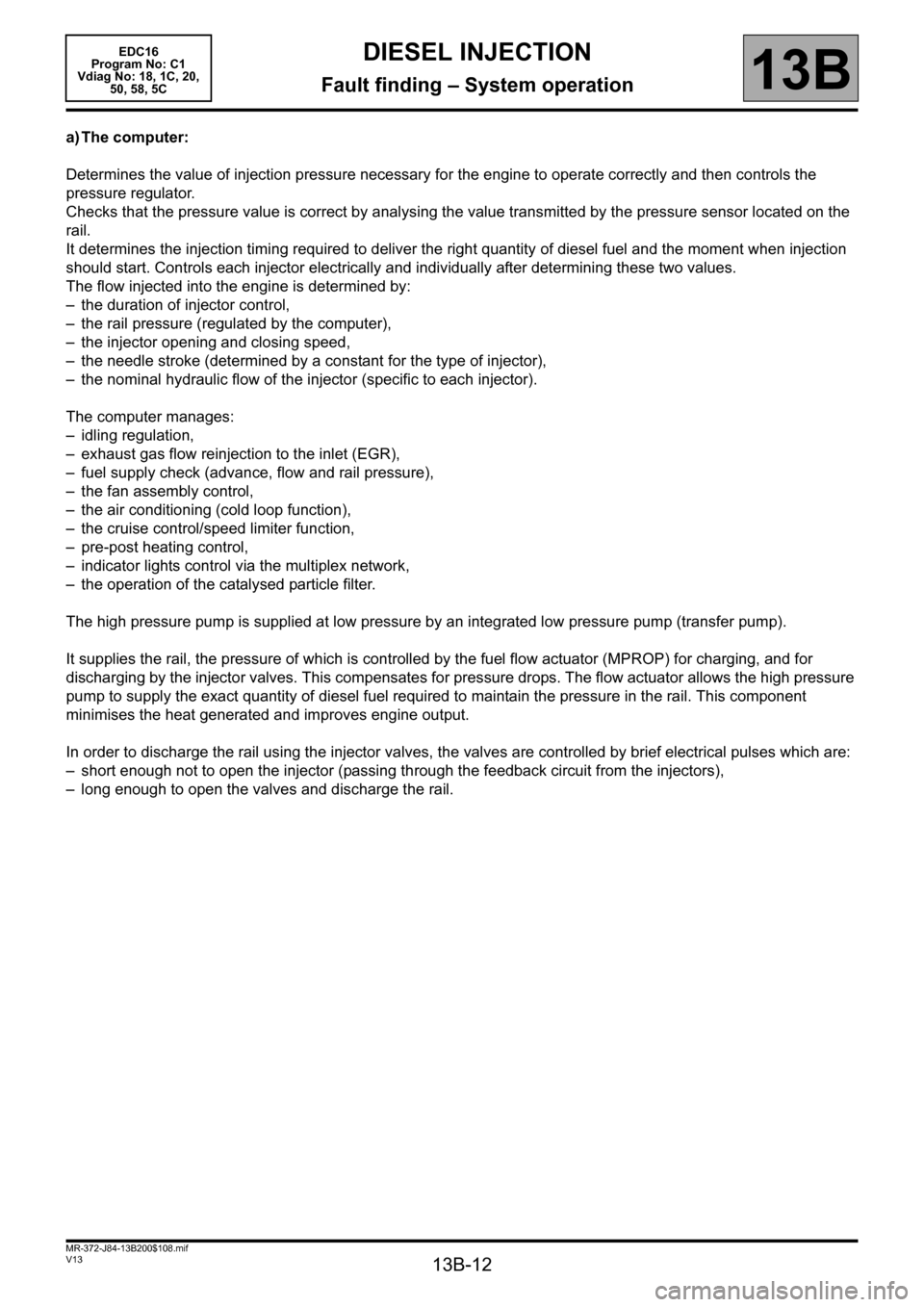
13B-12
MR-372-J84-13B200$108.mif
V13
DIESEL INJECTION
Fault finding – System operation
EDC16
Program No: C1
Vdiag No: 18, 1C, 20,
50, 58, 5C
13B
a) The computer:
Determines the value of injection pressure necessary for the engine to operate correctly and then controls the
pressure regulator.
Checks that the pressure value is correct by analysing the value transmitted by the pressure sensor located on the
rail.
It determines the injection timing required to deliver the right quantity of diesel fuel and the moment when injection
should start. Controls each injector electrically and individually after determining these two values.
The flow injected into the engine is determined by:
– the duration of injector control,
– the rail pressure (regulated by the computer),
– the injector opening and closing speed,
– the needle stroke (determined by a constant for the type of injector),
– the nominal hydraulic flow of the injector (specific to each injector).
The computer manages:
– idling regulation,
– exhaust gas flow reinjection to the inlet (EGR),
– fuel supply check (advance, flow and rail pressure),
– the fan assembly control,
– the air conditioning (cold loop function),
– the cruise control/speed limiter function,
– pre-post heating control,
– indicator lights control via the multiplex network,
– the operation of the catalysed particle filter.
The high pressure pump is supplied at low pressure by an integrated low pressure pump (transfer pump).
It supplies the rail, the pressure of which is controlled by the fuel flow actuator (MPROP) for charging, and for
discharging by the injector valves. This compensates for pressure drops. The flow actuator allows the high pressure
pump to supply the exact quantity of diesel fuel required to maintain the pressure in the rail. This component
minimises the heat generated and improves engine output.
In order to discharge the rail using the injector valves, the valves are controlled by brief electrical pulses which are:
– short enough not to open the injector (passing through the feedback circuit from the injectors),
– long enough to open the valves and discharge the rail.
Page 13 of 365
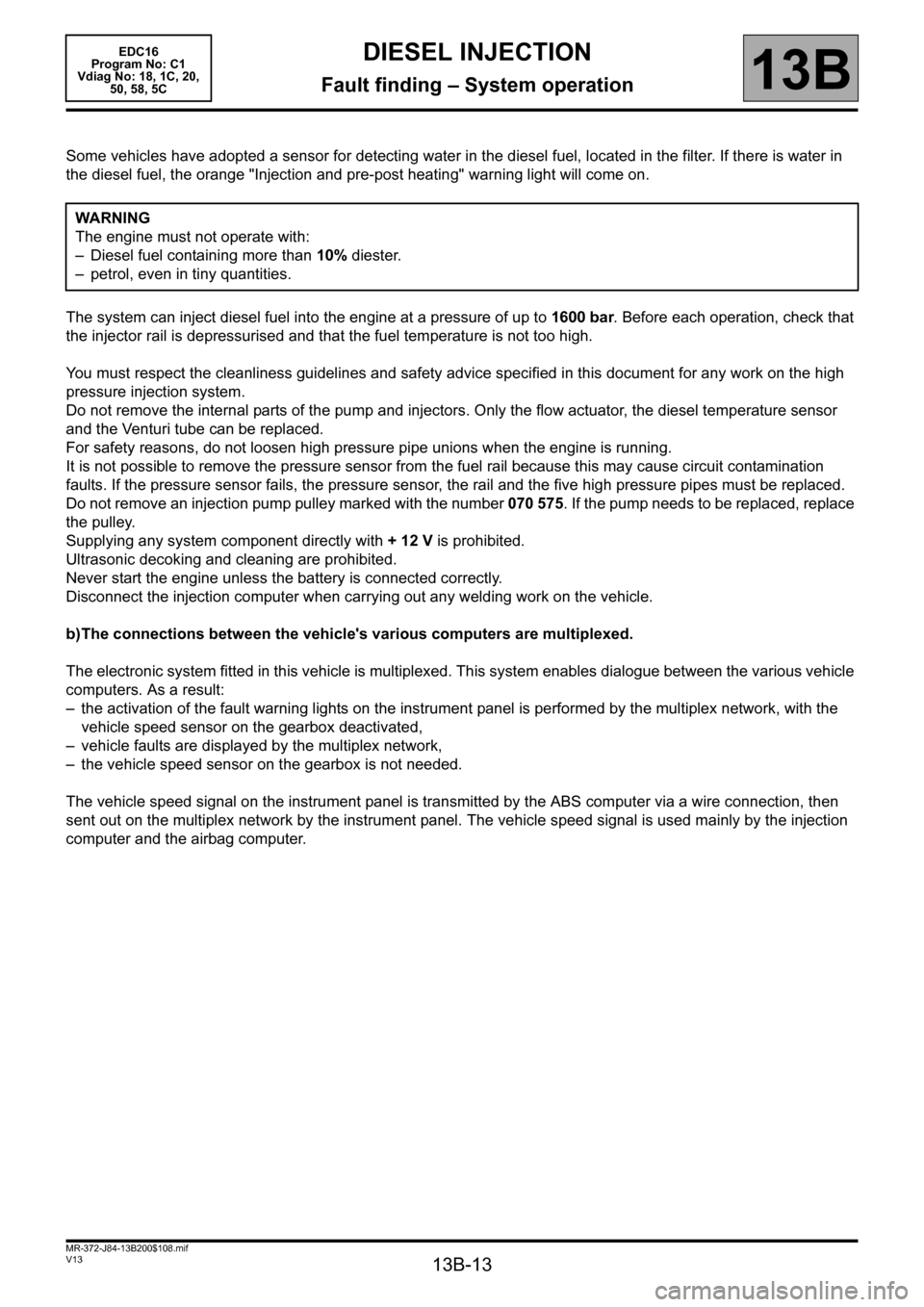
13B-13
MR-372-J84-13B200$108.mif
V13
DIESEL INJECTION
Fault finding – System operation
EDC16
Program No: C1
Vdiag No: 18, 1C, 20,
50, 58, 5C
13B
Some vehicles have adopted a sensor for detecting water in the diesel fuel, located in the filter. If there is water in
the diesel fuel, the orange "Injection and pre-post heating" warning light will come on.
The system can inject diesel fuel into the engine at a pressure of up to 1600 bar. Before each operation, check that
the injector rail is depressurised and that the fuel temperature is not too high.
You must respect the cleanliness guidelines and safety advice specified in this document for any work on the high
pressure injection system.
Do not remove the internal parts of the pump and injectors. Only the flow actuator, the diesel temperature sensor
and the Venturi tube can be replaced.
For safety reasons, do not loosen high pressure pipe unions when the engine is running.
It is not possible to remove the pressure sensor from the fuel rail because this may cause circuit contamination
faults. If the pressure sensor fails, the pressure sensor, the rail and the five high pressure pipes must be replaced.
Do not remove an injection pump pulley marked with the number 070 575. If the pump needs to be replaced, replace
the pulley.
Supplying any system component directly with +12V is prohibited.
Ultrasonic decoking and cleaning are prohibited.
Never start the engine unless the battery is connected correctly.
Disconnect the injection computer when carrying out any welding work on the vehicle.
b)The connections between the vehicle's various computers are multiplexed.
The electronic system fitted in this vehicle is multiplexed. This system enables dialogue between the various vehicle
computers. As a result:
– the activation of the fault warning lights on the instrument panel is performed by the multiplex network, with the
vehicle speed sensor on the gearbox deactivated,
– vehicle faults are displayed by the multiplex network,
– the vehicle speed sensor on the gearbox is not needed.
The vehicle speed signal on the instrument panel is transmitted by the ABS computer via a wire connection, then
sent out on the multiplex network by the instrument panel. The vehicle speed signal is used mainly by the injection
computer and the airbag computer.WARNING
The engine must not operate with:
– Diesel fuel containing more than 10% diester.
– petrol, even in tiny quantities.
Page 17 of 365
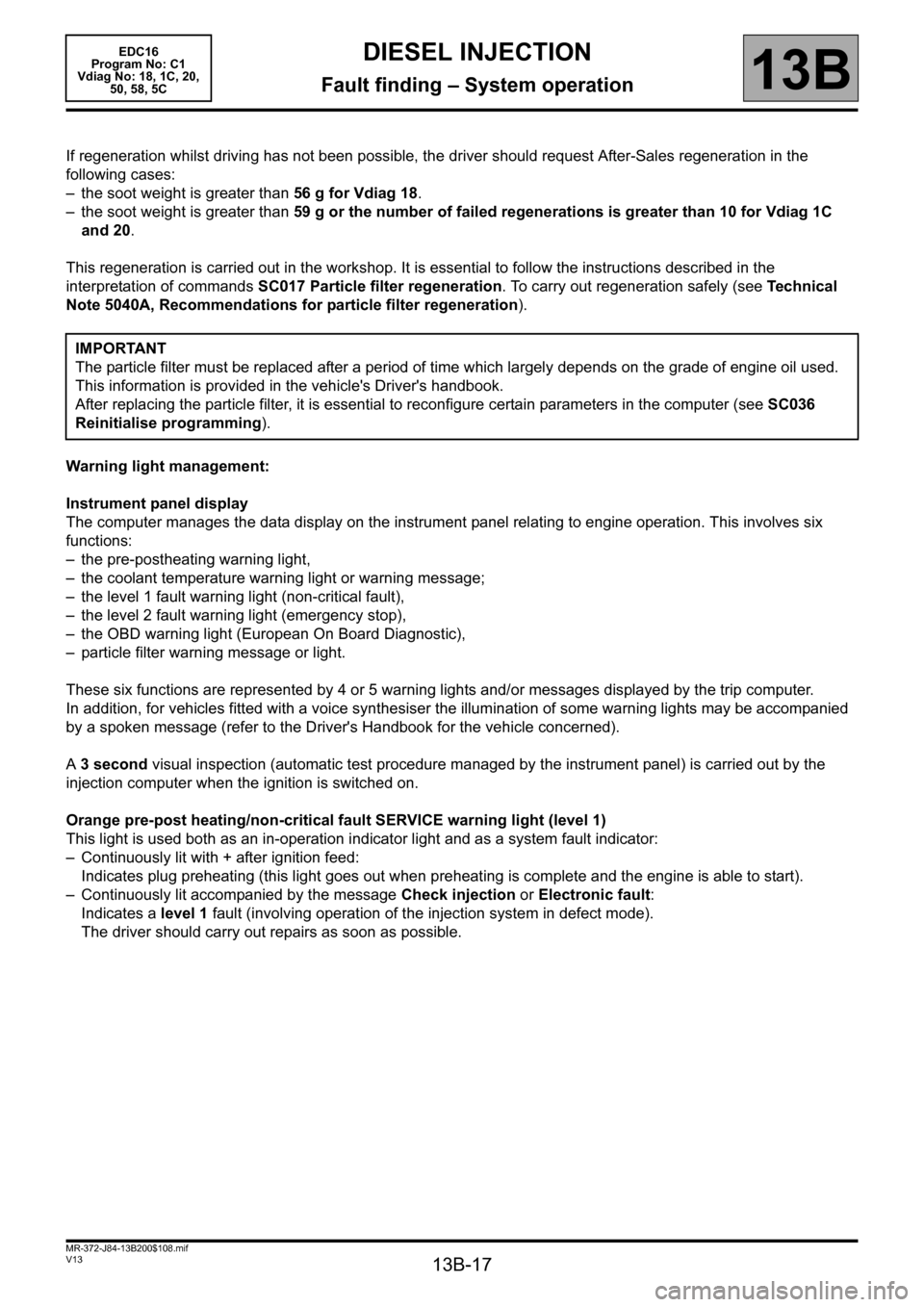
13B-17
MR-372-J84-13B200$108.mif
V13
DIESEL INJECTION
Fault finding – System operation
EDC16
Program No: C1
Vdiag No: 18, 1C, 20,
50, 58, 5C
13B
If regeneration whilst driving has not been possible, the driver should request After-Sales regeneration in the
following cases:
– the soot weight is greater than 56 g for Vdiag 18.
– the soot weight is greater than 59 g or the number of failed regenerations is greater than 10 for Vdiag 1C
and 20.
This regeneration is carried out in the workshop. It is essential to follow the instructions described in the
interpretation of commands SC017 Particle filter regeneration. To carry out regeneration safely (see Te c h n i c a l
Note 5040A, Recommendations for particle filter regeneration).
Warning light management:
Instrument panel display
The computer manages the data display on the instrument panel relating to engine operation. This involves six
functions:
– the pre-postheating warning light,
– the coolant temperature warning light or warning message;
– the level 1 fault warning light (non-critical fault),
– the level 2 fault warning light (emergency stop),
– the OBD warning light (European On Board Diagnostic),
– particle filter warning message or light.
These six functions are represented by 4 or 5 warning lights and/or messages displayed by the trip computer.
In addition, for vehicles fitted with a voice synthesiser the illumination of some warning lights may be accompanied
by a spoken message (refer to the Driver's Handbook for the vehicle concerned).
A 3 second visual inspection (automatic test procedure managed by the instrument panel) is carried out by the
injection computer when the ignition is switched on.
Orange pre-post heating/non-critical fault SERVICE warning light (level 1)
This light is used both as an in-operation indicator light and as a system fault indicator:
– Continuously lit with + after ignition feed:
Indicates plug preheating (this light goes out when preheating is complete and the engine is able to start).
– Continuously lit accompanied by the message Check injection or Electronic fault:
Indicates a level 1 fault (involving operation of the injection system in defect mode).
The driver should carry out repairs as soon as possible. IMPORTANT
The particle filter must be replaced after a period of time which largely depends on the grade of engine oil used.
This information is provided in the vehicle's Driver's handbook.
After replacing the particle filter, it is essential to reconfigure certain parameters in the computer (see SC036
Reinitialise programming).
Page 18 of 365
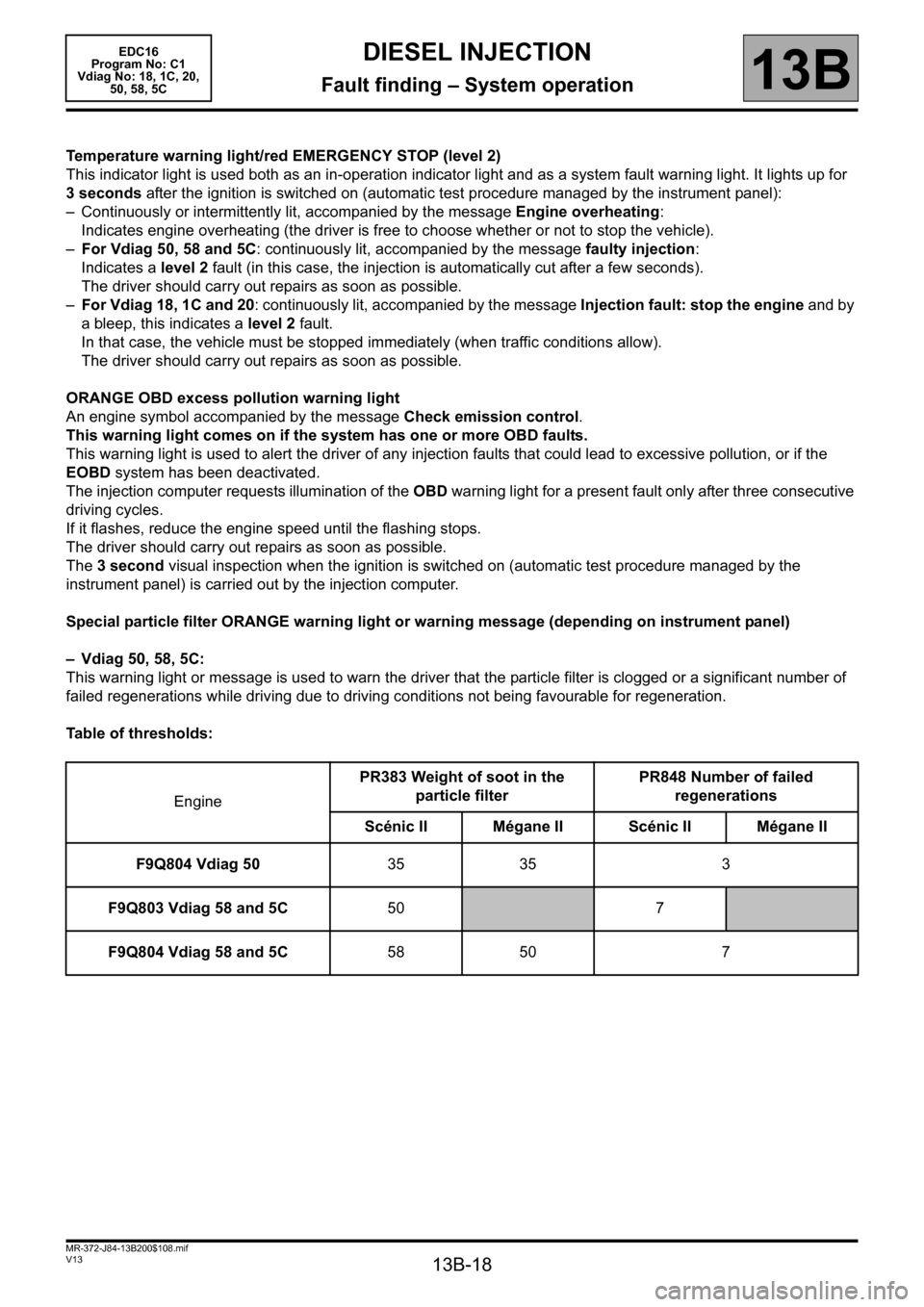
13B-18
MR-372-J84-13B200$108.mif
V13
DIESEL INJECTION
Fault finding – System operation
EDC16
Program No: C1
Vdiag No: 18, 1C, 20,
50, 58, 5C
13B
Temperature warning light/red EMERGENCY STOP (level 2)
This indicator light is used both as an in-operation indicator light and as a system fault warning light. It lights up for
3 seconds after the ignition is switched on (automatic test procedure managed by the instrument panel):
– Continuously or intermittently lit, accompanied by the message Engine overheating:
Indicates engine overheating (the driver is free to choose whether or not to stop the vehicle).
–For Vdiag 50, 58 and 5C: continuously lit, accompanied by the message faulty injection:
Indicates a level 2 fault (in this case, the injection is automatically cut after a few seconds).
The driver should carry out repairs as soon as possible.
–For Vdiag 18, 1C and 20: continuously lit, accompanied by the message Injection fault: stop the engine and by
a bleep, this indicates a level 2 fault.
In that case, the vehicle must be stopped immediately (when traffic conditions allow).
The driver should carry out repairs as soon as possible.
ORANGE OBD excess pollution warning light
An engine symbol accompanied by the message Check emission control.
This warning light comes on if the system has one or more OBD faults.
This warning light is used to alert the driver of any injection faults that could lead to excessive pollution, or if the
EOBD system has been deactivated.
The injection computer requests illumination of the OBD warning light for a present fault only after three consecutive
driving cycles.
If it flashes, reduce the engine speed until the flashing stops.
The driver should carry out repairs as soon as possible.
The 3 second visual inspection when the ignition is switched on (automatic test procedure managed by the
instrument panel) is carried out by the injection computer.
Special particle filter ORANGE warning light or warning message (depending on instrument panel)
– Vdiag 50, 58, 5C:
This warning light or message is used to warn the driver that the particle filter is clogged or a significant number of
failed regenerations while driving due to driving conditions not being favourable for regeneration.
Table of thresholds:
EnginePR383 Weight of soot in the
particle filterPR848 Number of failed
regenerations
Scénic II Mégane IIScénic II Mégane II
F9Q804 Vdiag 5035 35 3
F9Q803 Vdiag 58 and 5C50
7
F9Q804 Vdiag 58 and 5C58 50 7
Page 33 of 365
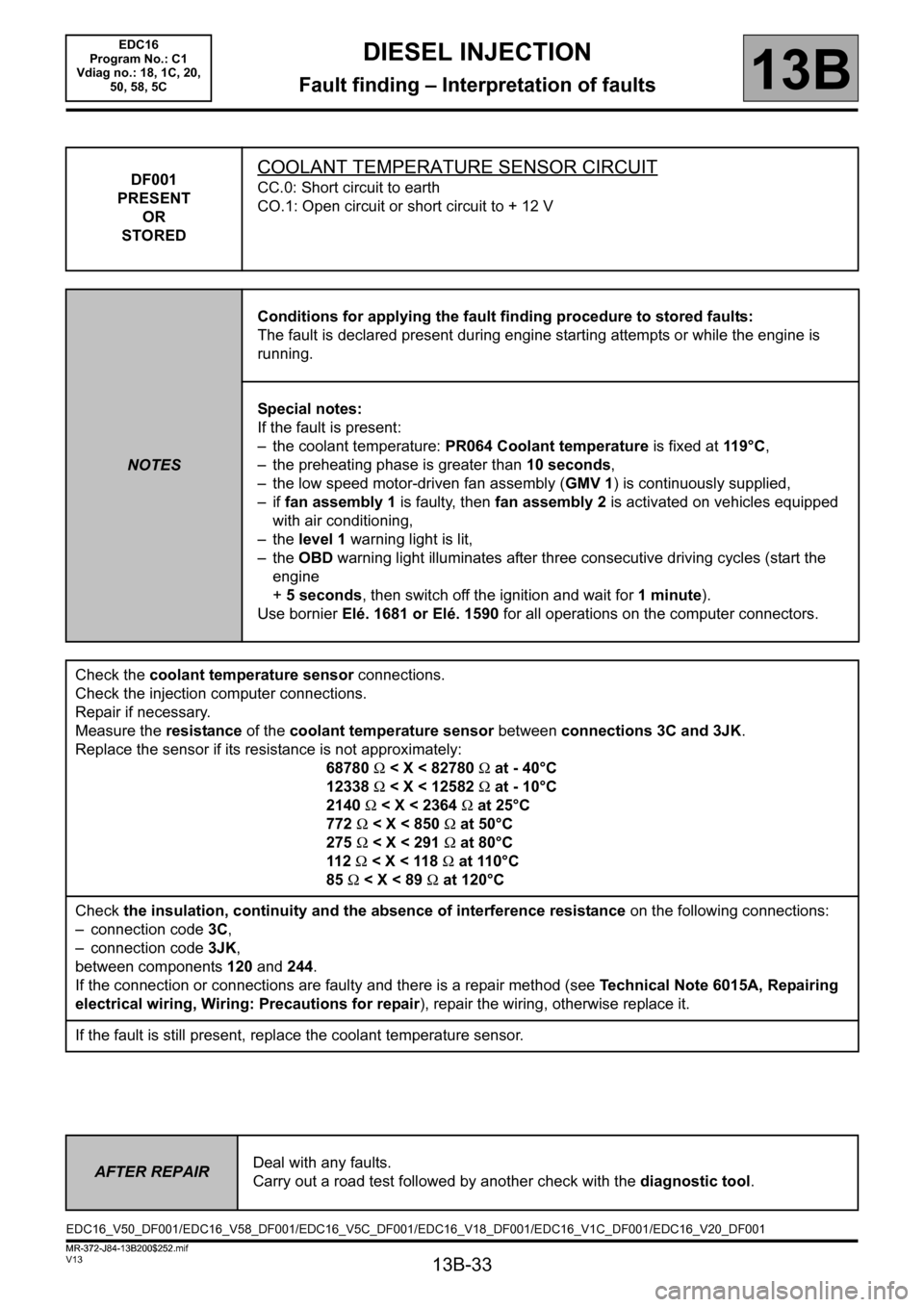
13B-33
MR-372-J84-13B200$252.mif
V13
13B
DIESEL INJECTION
Fault finding – Interpretation of faults
DF001
PRESENT
OR
STOREDCOOLANT TEMPERATURE SENSOR CIRCUIT
CC.0: Short circuit to earth
CO.1: Open circuit or short circuit to + 12 V
NOTESConditions for applying the fault finding procedure to stored faults:
The fault is declared present during engine starting attempts or while the engine is
running.
Special notes:
If the fault is present:
– the coolant temperature: PR064 Coolant temperature is fixed at 11 9 ° C,
– the preheating phase is greater than 10 seconds,
– the low speed motor-driven fan assembly (GMV 1) is continuously supplied,
–if fan assembly 1 is faulty, then fan assembly 2 is activated on vehicles equipped
with air conditioning,
– the level 1 warning light is lit,
– the OBD warning light illuminates after three consecutive driving cycles (start the
engine
+ 5 seconds, then switch off the ignition and wait for 1 minute).
Use bornier Elé. 1681 or Elé. 1590 for all operations on the computer connectors.
Check the coolant temperature sensor connections.
Check the injection computer connections.
Repair if necessary.
Measure the resistance of the coolant temperature sensor between connections 3C and 3JK.
Replace the sensor if its resistance is not approximately:
68780 Ω < X < 82780 Ω at - 40°C
12338 Ω < X < 12582 Ω at - 10°C
2140 Ω < X < 2364 Ω at 25°C
772 Ω < X < 850 Ω at 50°C
275 Ω < X < 291 Ω at 80°C
11 2 Ω < X < 118 Ω at 110°C
85 Ω < X < 89 Ω at 120°C
Check the insulation, continuity and the absence of interference resistance on the following connections:
– connection code3C,
– connection code 3JK,
between components 120 and 244.
If the connection or connections are faulty and there is a repair method (see Technical Note 6015A, Repairing
electrical wiring, Wiring: Precautions for repair), repair the wiring, otherwise replace it.
If the fault is still present, replace the coolant temperature sensor.
AFTER REPAIRDeal with any faults.
Carry out a road test followed by another check with the diagnostic tool.
EDC16_V50_DF001/EDC16_V58_DF001/EDC16_V5C_DF001/EDC16_V18_DF001/EDC16_V1C_DF001/EDC16_V20_DF001EDC16
Program No.: C1
Vdiag no.: 18, 1C, 20,
50, 58, 5C
MR-372-J84-13B200$252.mif
Page 34 of 365
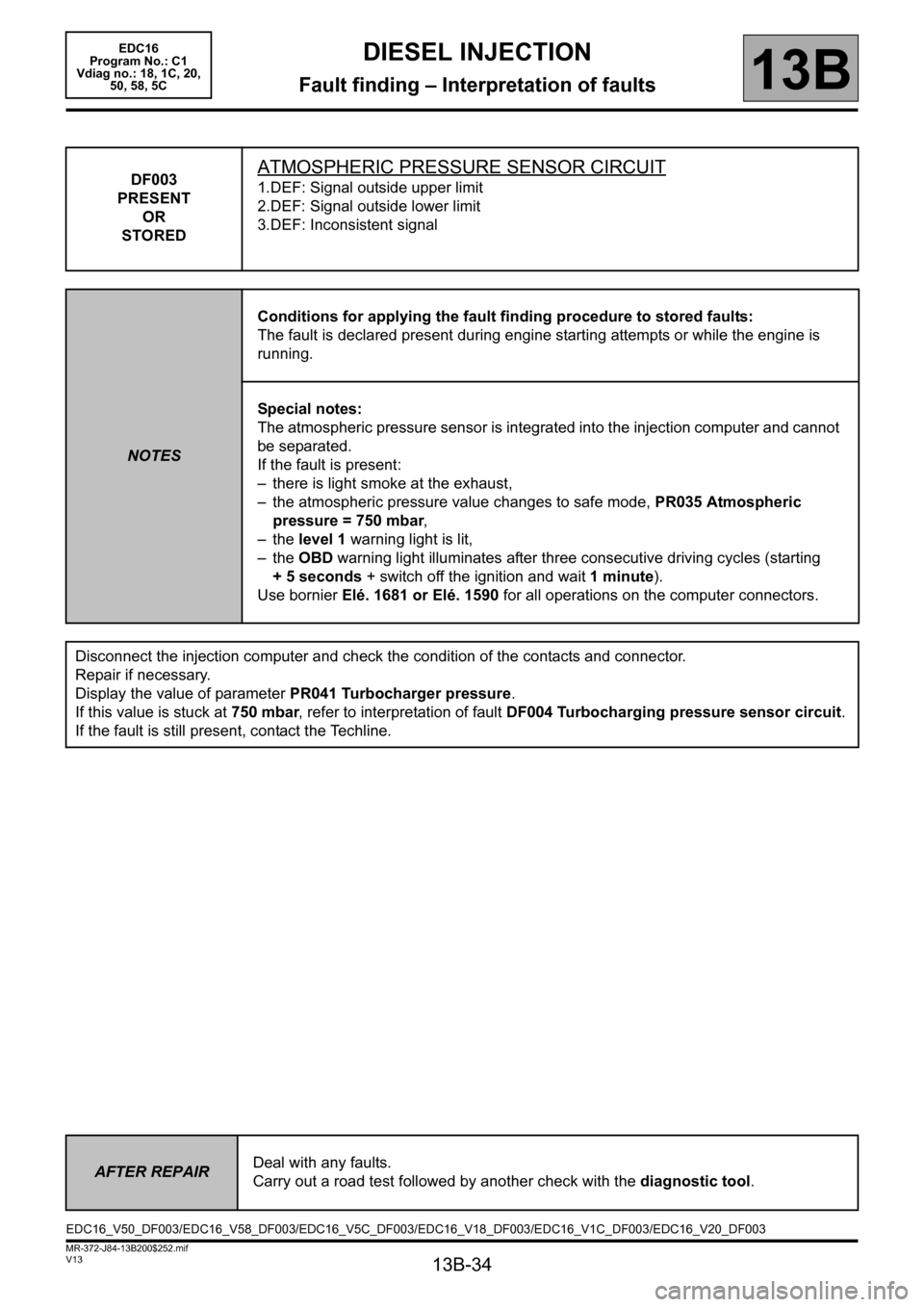
13B-34
MR-372-J84-13B200$252.mif
V13
DIESEL INJECTION
Fault finding – Interpretation of faults
EDC16
Program No.: C1
Vdiag no.: 18, 1C, 20,
50, 58, 5C
13B
DF003
PRESENT
OR
STOREDATMOSPHERIC PRESSURE SENSOR CIRCUIT
1.DEF: Signal outside upper limit
2.DEF: Signal outside lower limit
3.DEF: Inconsistent signal
NOTESConditions for applying the fault finding procedure to stored faults:
The fault is declared present during engine starting attempts or while the engine is
running.
Special notes:
The atmospheric pressure sensor is integrated into the injection computer and cannot
be separated.
If the fault is present:
– there is light smoke at the exhaust,
– the atmospheric pressure value changes to safe mode, PR035 Atmospheric
pressure = 750 mbar,
– the level 1 warning light is lit,
– the OBD warning light illuminates after three consecutive driving cycles (starting
+ 5 seconds + switch off the ignition and wait 1 minute).
Use bornier Elé. 1681 or Elé. 1590 for all operations on the computer connectors.
Disconnect the injection computer and check the condition of the contacts and connector.
Repair if necessary.
Display the value of parameter PR041 Turbocharger pressure.
If this value is stuck at 750 mbar, refer to interpretation of fault DF004 Turbocharging pressure sensor circuit.
If the fault is still present, contact the Techline.
AFTER REPAIRDeal with any faults.
Carry out a road test followed by another check with the diagnostic tool.
EDC16_V50_DF003/EDC16_V58_DF003/EDC16_V5C_DF003/EDC16_V18_DF003/EDC16_V1C_DF003/EDC16_V20_DF003
Page 35 of 365
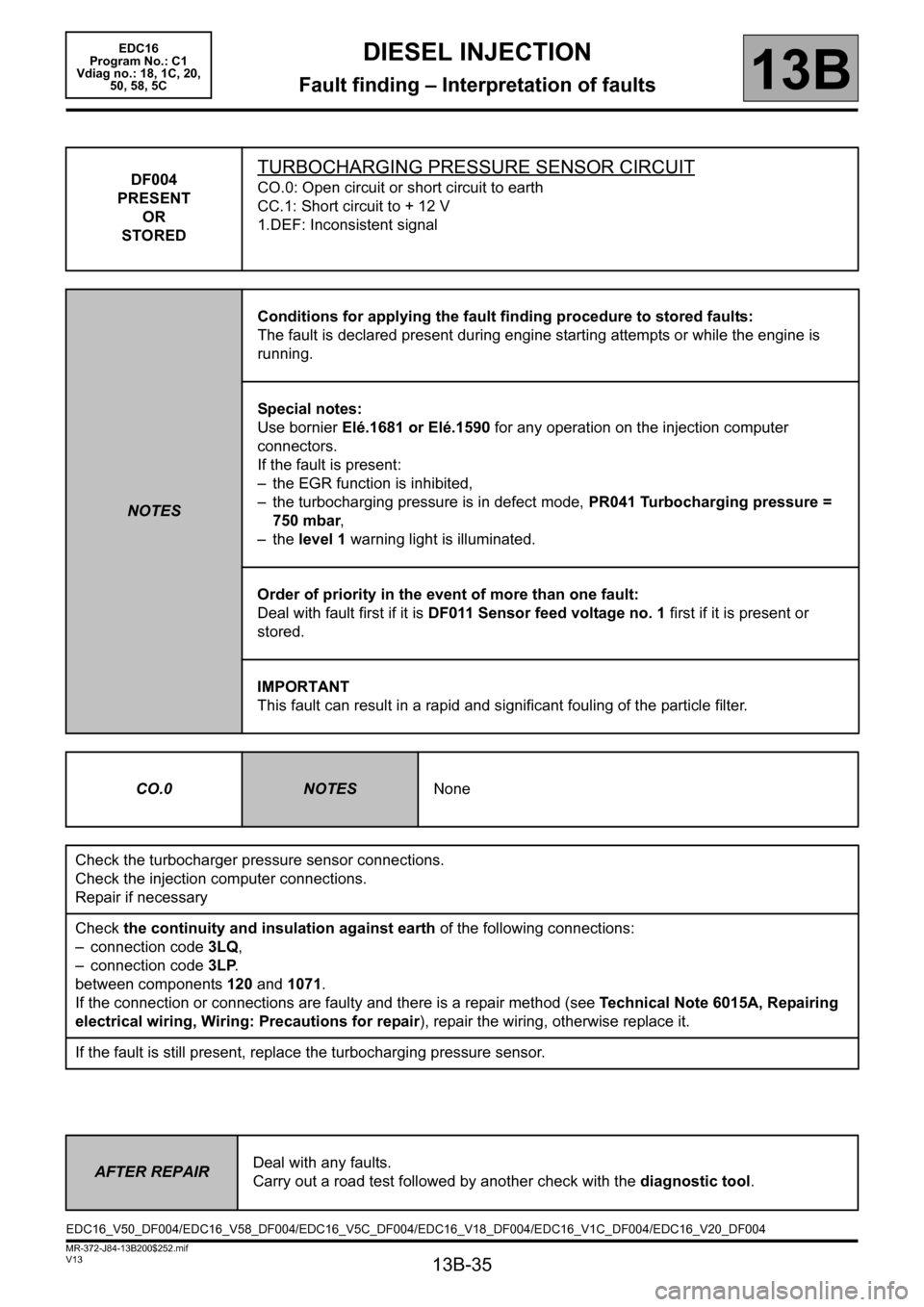
13B-35
MR-372-J84-13B200$252.mif
V13
DIESEL INJECTION
Fault finding – Interpretation of faults
EDC16
Program No.: C1
Vdiag no.: 18, 1C, 20,
50, 58, 5C
13B
DF004
PRESENT
OR
STOREDTURBOCHARGING PRESSURE SENSOR CIRCUIT
CO.0: Open circuit or short circuit to earth
CC.1: Short circuit to + 12 V
1.DEF: Inconsistent signal
NOTESConditions for applying the fault finding procedure to stored faults:
The fault is declared present during engine starting attempts or while the engine is
running.
Special notes:
Use bornier Elé.1681 or Elé.1590 for any operation on the injection computer
connectors.
If the fault is present:
– the EGR function is inhibited,
– the turbocharging pressure is in defect mode, PR041 Turbocharging pressure =
750 mbar,
– the level 1 warning light is illuminated.
Order of priority in the event of more than one fault:
Deal with fault first if it is DF011 Sensor feed voltage no. 1 first if it is present or
stored.
IMPORTANT
This fault can result in a rapid and significant fouling of the particle filter.
CO.0
NOTESNone
Check the turbocharger pressure sensor connections.
Check the injection computer connections.
Repair if necessary
Check the continuity and insulation against earth of the following connections:
– connection code 3LQ,
– connection code 3LP.
between components 120 and 1071.
If the connection or connections are faulty and there is a repair method (see Technical Note 6015A, Repairing
electrical wiring, Wiring: Precautions for repair), repair the wiring, otherwise replace it.
If the fault is still present, replace the turbocharging pressure sensor.
AFTER REPAIRDeal with any faults.
Carry out a road test followed by another check with the diagnostic tool.
EDC16_V50_DF004/EDC16_V58_DF004/EDC16_V5C_DF004/EDC16_V18_DF004/EDC16_V1C_DF004/EDC16_V20_DF004
Page 37 of 365

13B-37
MR-372-J84-13B200$252.mif
V13
DIESEL INJECTION
Fault finding – Interpretation of faults
EDC16
Program No.: C1
Vdiag no.: 18, 1C, 20,
50, 58, 5C
13B
DF005
PRESENT
OR
STOREDENGINE SPEED SENSOR CIRCUIT
1.DEF : No signal
2.DEF : Inconsistent signal
NOTESConditions for applying the fault finding procedure to a stored fault:
The fault is declared present during engine starting attempts or while the engine is
running.
Special notes:
Use bornier Ele. 1681 or Ele. 1590 for all operations on the computer connectors.
The engine speed sensor is consistent with the camshaft sensor.
If the fault is present:
– it is impossible to start the engine or the engine stops,
– the level 2 warning light is lit.
Check the engine speed sensor connections.
Repair if necessary.
Check that the sensor is correctly mounted and that the flywheel target is not damaged.
Check that the gap between the engine speed sensor and the engine flywheel is 0.5 to 1.8 mm.
Measure the resistance of the engine speed sensor between terminals A and B of its black connector.
Replace the engine speed sensor if its winding resistance is not 510 Ω < X < 850 Ω for an engine temperature of
20°C.
Check the injection computer connections.
Repair if necessary.
Check for continuity and the absence of interference resistance of the following connections:
– connection code 3BG,
– connection code 3BL.
between components 120 and 149.
If the connection or connections are faulty and there is a repair method (see Technical Note 6015A, Repairing
electrical wiring, Wiring: Precautions for repair), repair the wiring, otherwise replace it.
If the fault is still present, contact the Techline.
AFTER REPAIRDeal with any faults.
Carry out a road test followed by another check with the diagnostic tool.
EDC16_V50_DF005/EDC16_V58_DF005/EDC16_V5C_DF005/EDC16_V18_DF005/EDC16_V1C_DF005/EDC16_V20_DF005
Page 38 of 365
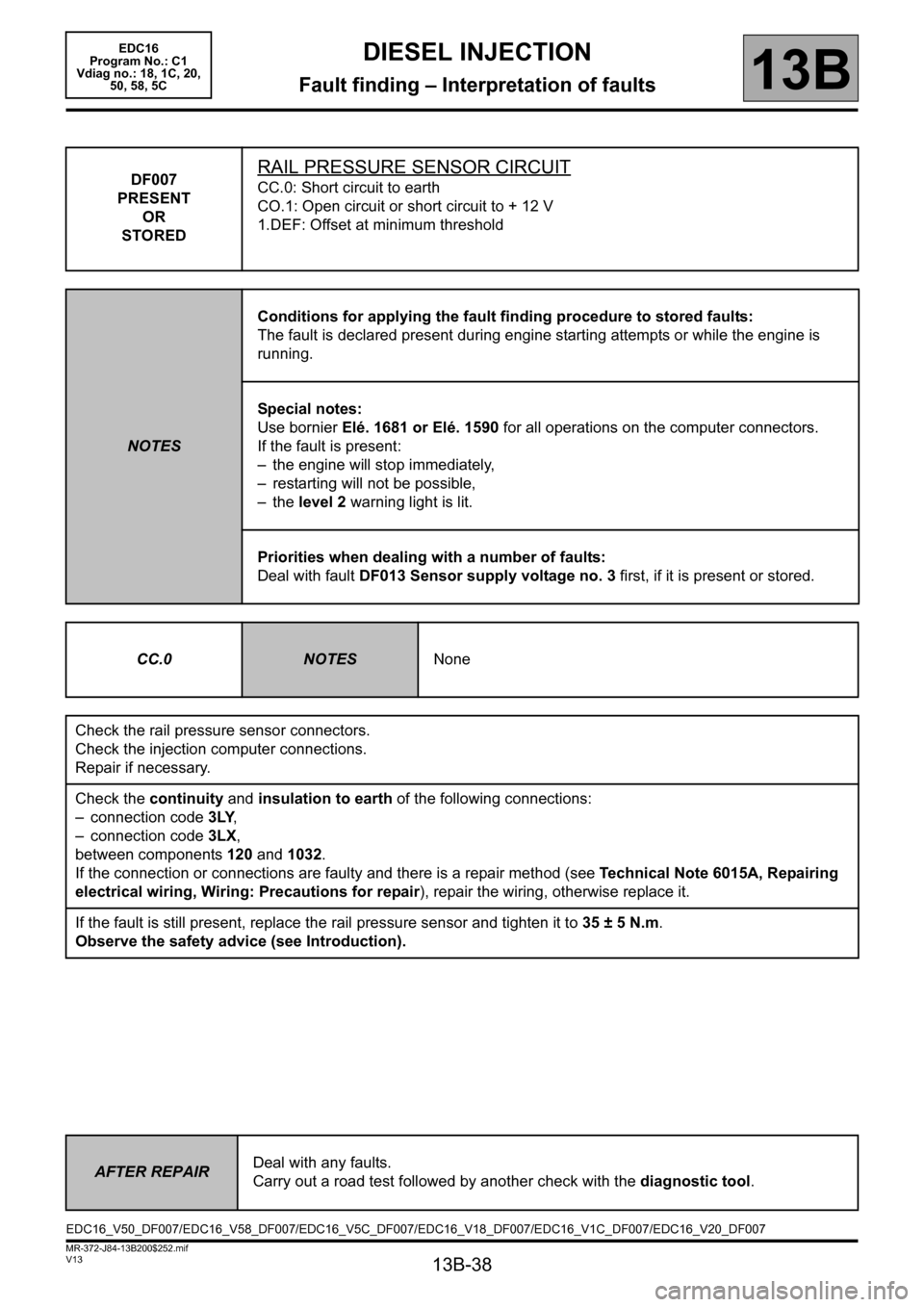
13B-38
MR-372-J84-13B200$252.mif
V13
DIESEL INJECTION
Fault finding – Interpretation of faults
EDC16
Program No.: C1
Vdiag no.: 18, 1C, 20,
50, 58, 5C
13B
DF007
PRESENT
OR
STOREDRAIL PRESSURE SENSOR CIRCUIT
CC.0: Short circuit to earth
CO.1: Open circuit or short circuit to + 12 V
1.DEF: Offset at minimum threshold
NOTESConditions for applying the fault finding procedure to stored faults:
The fault is declared present during engine starting attempts or while the engine is
running.
Special notes:
Use bornier Elé. 1681 or Elé. 1590 for all operations on the computer connectors.
If the fault is present:
– the engine will stop immediately,
– restarting will not be possible,
–the level 2 warning light is lit.
Priorities when dealing with a number of faults:
Deal with fault DF013 Sensor supply voltage no. 3 first, if it is present or stored.
CC.0
NOTESNone
Check the rail pressure sensor connectors.
Check the injection computer connections.
Repair if necessary.
Check the continuity and insulation to earth of the following connections:
– connection code 3LY,
– connection code 3LX,
between components 120 and 1032.
If the connection or connections are faulty and there is a repair method (see Technical Note 6015A, Repairing
electrical wiring, Wiring: Precautions for repair), repair the wiring, otherwise replace it.
If the fault is still present, replace the rail pressure sensor and tighten it to 35 ± 5 N.m.
Observe the safety advice (see Introduction).
AFTER REPAIRDeal with any faults.
Carry out a road test followed by another check with the diagnostic tool.
EDC16_V50_DF007/EDC16_V58_DF007/EDC16_V5C_DF007/EDC16_V18_DF007/EDC16_V1C_DF007/EDC16_V20_DF007
Page 40 of 365
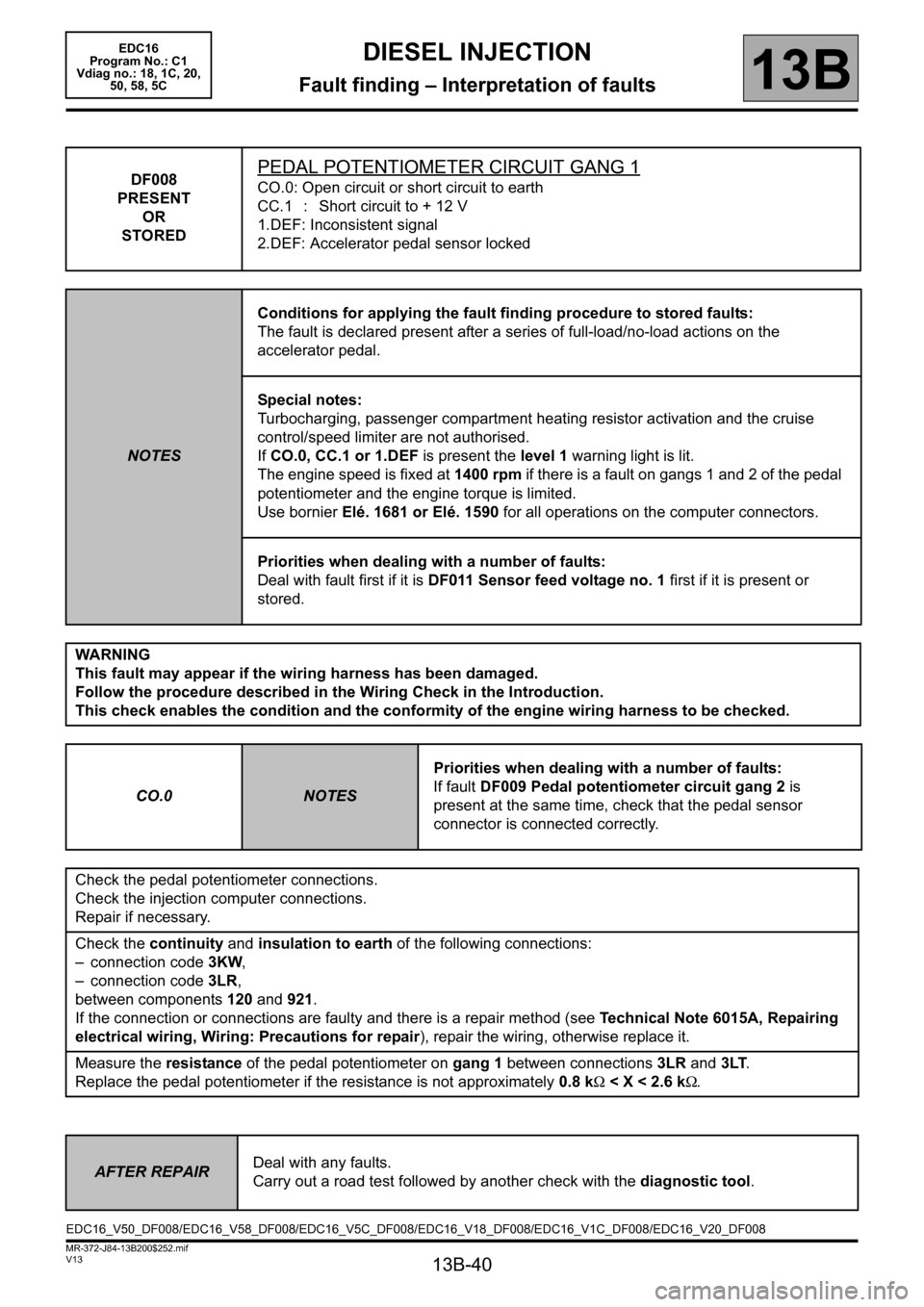
13B-40
MR-372-J84-13B200$252.mif
V13
DIESEL INJECTION
Fault finding – Interpretation of faults
EDC16
Program No.: C1
Vdiag no.: 18, 1C, 20,
50, 58, 5C
13B
DF008
PRESENT
OR
STOREDPEDAL POTENTIOMETER CIRCUIT GANG 1
CO.0: Open circuit or short circuit to earth
CC.1 : Short circuit to + 12 V
1.DEF: Inconsistent signal
2.DEF: Accelerator pedal sensor locked
NOTESConditions for applying the fault finding procedure to stored faults:
The fault is declared present after a series of full-load/no-load actions on the
accelerator pedal.
Special notes:
Turbocharging, passenger compartment heating resistor activation and the cruise
control/speed limiter are not authorised.
If CO.0, CC.1 or 1.DEF is present the level 1 warning light is lit.
The engine speed is fixed at 1400 rpm if there is a fault on gangs 1 and 2 of the pedal
potentiometer and the engine torque is limited.
Use bornier Elé. 1681 or Elé. 1590 for all operations on the computer connectors.
Priorities when dealing with a number of faults:
Deal with fault first if it is DF011 Sensor feed voltage no. 1 first if it is present or
stored.
WARNING
This fault may appear if the wiring harness has been damaged.
Follow the procedure described in the Wiring Check in the Introduction.
This check enables the condition and the conformity of the engine wiring harness to be checked.
CO.0
NOTESPriorities when dealing with a number of faults:
If fault DF009 Pedal potentiometer circuit gang 2 is
present at the same time, check that the pedal sensor
connector is connected correctly.
Check the pedal potentiometer connections.
Check the injection computer connections.
Repair if necessary.
Check the continuity and insulation to earth of the following connections:
– connection code 3KW,
– connection code 3LR,
between components 120 and 921.
If the connection or connections are faulty and there is a repair method (see Technical Note 6015A, Repairing
electrical wiring, Wiring: Precautions for repair), repair the wiring, otherwise replace it.
Measure the resistance of the pedal potentiometer on gang 1 between connections 3LR and 3LT.
Replace the pedal potentiometer if the resistance is not approximately 0.8 kΩ < X < 2.6 kΩ.
AFTER REPAIRDeal with any faults.
Carry out a road test followed by another check with the diagnostic tool.
EDC16_V50_DF008/EDC16_V58_DF008/EDC16_V5C_DF008/EDC16_V18_DF008/EDC16_V1C_DF008/EDC16_V20_DF008